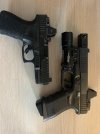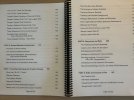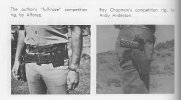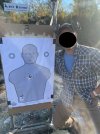Overview - From OCT 14-18, I attended Range Master’s Defensive Pistol Instructor Development course at Last Resort Firearms Training in White Hall Arkansas. This was an open enrollment class with a mix of local, state, and federal LE and civilians.
The instruction for the classes was provided by Tom Givens, a retired police officer from the city of Memphis, TN. Mr. Givens has been teaching firearms for over 50 years. He has taught with some of the legends in the industry including Col. Jeff Cooper. Additional instruction was provided by John Hearne from Two Pillars Training, and Tiffany Johnson, a practicing attorney in TN.
Mr. Hearne’s presentation was especially interesting and probably warrants an AAR all its own. Fortunately, I found one someone already wrote. You can check it out here.
GEAR - I wore the same holster and magazine pouch that I wear day to day as a CCW rig. They are both from JM Custom Kydex. I shot the class from concealment so I just dressed the way I normally dress when I leave the house.
GUNS - I shot my G19 with an RMR and Surefire X300. The pistol has a threaded KKM barrel and a comp on it. I originally did that as kind of a goof when I saw Chuck Pressburg’s gun several years ago. Afterall, who the hell comps a 9mm? But I found that it keeps my light clean while I’m shooting and doesn’t add any length beyond the light, so I kept it. I brought a backup G19 but it wasn’t needed (two actually, and spare parts… I learned something from the Modern Day Sniper class).

POI – This class was heavily focused on instructor development. We spent about half the time in the classroom and the other half on the range.
The classroom portion of the class was a lot more intensive than I expected. On arrival on T-day 1, the students were given a 248pg handbook and at the end of the class there was an 80-question test on the material. Topics covered ranged from adult learning to violent crime statistics, to handgun nomenclature, to diagnosing problem shooters.

Mr. Givens stated several times that an effective instructor should know what they are teaching and also *why* they are teaching it. That means understanding the history of the tools, training methodologies, and handgun techniques. This was a big part of why I wanted to take Mr. Givens class.
A little over ten years ago I started to notice some of the ideas that were very talked about when I first started carrying a gun, and had fallen out of favor, were starting to come around again. I was fortunate enough to have access to a man named Pat Rogers who had been teaching firearms for a long time. Pat laughingly told me that a lot of things in firearms training was cyclical and he suggested that I read up on some of the old shooters/gunfighters.
(Dropped and offset holsters are so new and fancy)

I bought a lot of books by and about men like Charles Askins, Jelly Bryce, Bill Jordan, Jim Cirillo, and of course, Jeff Cooper. Mr. Givens was a student of and a direct peer of some of the legends in the pistol world and I wanted to hear information from as close to the source as I could. As an example, Mr. Givens was taught the Harries flashlight technique by… Mike Harries. I don’t care for the technique but having that direct line to the origin of a lot of modern pistol techniques isn’t something I wanted to overlook.
There has been a lot of information relayed by people who were never on the Gram.
On the range, Tom broke the class into two relays. Relay one stayed on the same target throughout the class, relay two shifted one shooter to the right every day. This allowed everyone to work with five different coach/shooter combinations. None of the drills were particularly aggressive but all of them demanded time management and round accountability. Some of the drills we shot are below. I’ll be adding them to my little book of drills to pull out for less experienced shooters on future range trips.
Baseline Skills Assessment Drill
Use a B-8 repair center, FBI-IP-1 bullseye, or the bullseye on an LTT-1 target, scored as printed. This drill is intended to be shot cold, from concealed carry.
-5 yards Draw and fire 5 rounds in 5 seconds, using both hands.
-5 yards Start gun in hand, at Ready, in dominant hand only. Fire 3 rounds in 3 seconds.
-5 yards Start gun in hand, at Ready, in non-dominant hand only. Fire 2 rounds in 3 seconds.
-7 yards Start gun in hand, loaded with 3 rounds only. Fire 3 rounds, conduct an empty gun reload, and fire 3 more rounds, all in 10 seconds.
-10 yards Start gun in hand, at Ready. Fire 4 rounds in 4 seconds. 20 rounds total.
Possible score = 200 (my score was a 199)
RANGEMASTER Bullseye course
Use a B-8 repair center, FBI-IP-1 bullseye, or the bullseye on an LTT-1 target, scored as printed. This drill is intended to be shot from concealed carry.
-25 yards. On signal, fire 5 rounds in one minute.
-15 yards. On signal fire 5 rounds in 15 seconds.
-15 yards. on signal fire 5 rounds in 10 seconds.
-7 yards. Start with only 5 rounds in the pistol and have a spare magazine. On signal, fire 5 rounds, reload, and fire 5 more rounds, in 15 seconds.
- 5 yards. On signal, fire 5 rounds in 5 seconds.
Possible score = 300.
Rangemaster Instructor Qualification
Use an RFTS-Q Target scored 5/4/2 or an IDPA with head circle scored 5/2/0
-2 yd From position 3. Start muzzle averted to left or right of target. On signal, rotate on target, fire 3 rounds in 2 seconds (from position 3). (x2)
-3 yd Draw and fire 3 rounds strong-hand-only, switch hands, 3 rounds weak-hand-only, all in 7 seconds.
-3 yd Draw and fire 4 rounds in 3 seconds. (x2)
-5 yd Draw and fire 3 rounds in 3 seconds. (x2)
-5 yd Draw and fire 3 rounds to the chest, 1 round to the head, all in 4 seconds. (x2)
-5 yd From the ready, fire 1 round to the head in 1.5 seconds. (x2)
-7 yd From the ready, fire 4 (3+1) rounds in gun. Fire 4 rounds, reload, 4 rounds, all in 8 seconds.
-7 yd From the ready, empty chamber, loaded magazine in place. On signal, attempt to fire (it must go click!), apply immediate action, fire 2 rounds, all in 5 seconds.
-15 yd Draw and fire 2 rounds in 5 seconds.
-15 yd Draw and fire 3 rounds in 6 seconds.
-25 yd Draw and fire 4 rounds standing, 5 rounds kneeling, in 20 seconds.
Scoring
60 rounds total. 300 possible points. 270 or higher (90%) to pass. (cleaned it)

We also shot the casino drill, parrot drill, and several others.
One of the components that Mr. Givens stressed repeatedly was that the CoF you shoot should assess multiple elements of both gun handling and marksmanship. It should be timed and scored, and you should use it as a tool to assess what you need to focus on in your training.
I wholeheartedly believe that there is a place for focused accuracy work, I start most of my trips to the range with a slow fire, 25yd, 10rd string on a B8. It’s something that I can use over time to get a good gauge on my capabilities and see trends in my marksmanship.
That being said, I agree with Mr. Givens that something like a slow fire, 10rd string doesn’t assess anything other than marksmanship. We need to make sure we’re working on all the elements of fighting with a handgun. Strong hand only, support hand only, presentations, reloads, malfunctions, etc. It’s easy to focus on the easy stuff.
A CoF that assesses marksmanship, gun handling, and timing (changing pace when changing target size/distance. See “Parrot Drill”) will give you a good idea of where you should focus your attention during your practice.
LESSONS LEARNED – Way back in 2006 I attended my first open enrollment class. Before I went, I asked a co-worker who was very active in the training community if he had any advice. He told me to treat every class like it was a job interview. I’ve tried to take that information to heart over the years.
In this class, I was joined by Matt Landfair (neither of us knew the other was attending) and I ended up shooting with a retired Col who was once the commanding officer of a buddy of mine (who now teaches for TNVC). The Col and I didn’t figure out that we only had one degree of separation until late in the class. Imagine if I had been in the class acting like an asshole and that had gone directly back to my buddy. Walk soft. You never know who you are going to be on the line with.
OVERALL – This class was almost exactly what I was hoping it would be. A lot of historical perspective, some good information on coaching individual shooters, and a bucket load of information on effective teaching. If you’re looking for a class to make you a better pistol shooter, there are a lot better places to go. If you’re teaching or running classes at your home range, there is a mountain of good information.
The instruction for the classes was provided by Tom Givens, a retired police officer from the city of Memphis, TN. Mr. Givens has been teaching firearms for over 50 years. He has taught with some of the legends in the industry including Col. Jeff Cooper. Additional instruction was provided by John Hearne from Two Pillars Training, and Tiffany Johnson, a practicing attorney in TN.
Mr. Hearne’s presentation was especially interesting and probably warrants an AAR all its own. Fortunately, I found one someone already wrote. You can check it out here.
GEAR - I wore the same holster and magazine pouch that I wear day to day as a CCW rig. They are both from JM Custom Kydex. I shot the class from concealment so I just dressed the way I normally dress when I leave the house.
GUNS - I shot my G19 with an RMR and Surefire X300. The pistol has a threaded KKM barrel and a comp on it. I originally did that as kind of a goof when I saw Chuck Pressburg’s gun several years ago. Afterall, who the hell comps a 9mm? But I found that it keeps my light clean while I’m shooting and doesn’t add any length beyond the light, so I kept it. I brought a backup G19 but it wasn’t needed (two actually, and spare parts… I learned something from the Modern Day Sniper class).

POI – This class was heavily focused on instructor development. We spent about half the time in the classroom and the other half on the range.
The classroom portion of the class was a lot more intensive than I expected. On arrival on T-day 1, the students were given a 248pg handbook and at the end of the class there was an 80-question test on the material. Topics covered ranged from adult learning to violent crime statistics, to handgun nomenclature, to diagnosing problem shooters.

Mr. Givens stated several times that an effective instructor should know what they are teaching and also *why* they are teaching it. That means understanding the history of the tools, training methodologies, and handgun techniques. This was a big part of why I wanted to take Mr. Givens class.
A little over ten years ago I started to notice some of the ideas that were very talked about when I first started carrying a gun, and had fallen out of favor, were starting to come around again. I was fortunate enough to have access to a man named Pat Rogers who had been teaching firearms for a long time. Pat laughingly told me that a lot of things in firearms training was cyclical and he suggested that I read up on some of the old shooters/gunfighters.
(Dropped and offset holsters are so new and fancy)

I bought a lot of books by and about men like Charles Askins, Jelly Bryce, Bill Jordan, Jim Cirillo, and of course, Jeff Cooper. Mr. Givens was a student of and a direct peer of some of the legends in the pistol world and I wanted to hear information from as close to the source as I could. As an example, Mr. Givens was taught the Harries flashlight technique by… Mike Harries. I don’t care for the technique but having that direct line to the origin of a lot of modern pistol techniques isn’t something I wanted to overlook.
There has been a lot of information relayed by people who were never on the Gram.
On the range, Tom broke the class into two relays. Relay one stayed on the same target throughout the class, relay two shifted one shooter to the right every day. This allowed everyone to work with five different coach/shooter combinations. None of the drills were particularly aggressive but all of them demanded time management and round accountability. Some of the drills we shot are below. I’ll be adding them to my little book of drills to pull out for less experienced shooters on future range trips.
Baseline Skills Assessment Drill
Use a B-8 repair center, FBI-IP-1 bullseye, or the bullseye on an LTT-1 target, scored as printed. This drill is intended to be shot cold, from concealed carry.
-5 yards Draw and fire 5 rounds in 5 seconds, using both hands.
-5 yards Start gun in hand, at Ready, in dominant hand only. Fire 3 rounds in 3 seconds.
-5 yards Start gun in hand, at Ready, in non-dominant hand only. Fire 2 rounds in 3 seconds.
-7 yards Start gun in hand, loaded with 3 rounds only. Fire 3 rounds, conduct an empty gun reload, and fire 3 more rounds, all in 10 seconds.
-10 yards Start gun in hand, at Ready. Fire 4 rounds in 4 seconds. 20 rounds total.
Possible score = 200 (my score was a 199)
RANGEMASTER Bullseye course
Use a B-8 repair center, FBI-IP-1 bullseye, or the bullseye on an LTT-1 target, scored as printed. This drill is intended to be shot from concealed carry.
-25 yards. On signal, fire 5 rounds in one minute.
-15 yards. On signal fire 5 rounds in 15 seconds.
-15 yards. on signal fire 5 rounds in 10 seconds.
-7 yards. Start with only 5 rounds in the pistol and have a spare magazine. On signal, fire 5 rounds, reload, and fire 5 more rounds, in 15 seconds.
- 5 yards. On signal, fire 5 rounds in 5 seconds.
Possible score = 300.
Rangemaster Instructor Qualification
Use an RFTS-Q Target scored 5/4/2 or an IDPA with head circle scored 5/2/0
-2 yd From position 3. Start muzzle averted to left or right of target. On signal, rotate on target, fire 3 rounds in 2 seconds (from position 3). (x2)
-3 yd Draw and fire 3 rounds strong-hand-only, switch hands, 3 rounds weak-hand-only, all in 7 seconds.
-3 yd Draw and fire 4 rounds in 3 seconds. (x2)
-5 yd Draw and fire 3 rounds in 3 seconds. (x2)
-5 yd Draw and fire 3 rounds to the chest, 1 round to the head, all in 4 seconds. (x2)
-5 yd From the ready, fire 1 round to the head in 1.5 seconds. (x2)
-7 yd From the ready, fire 4 (3+1) rounds in gun. Fire 4 rounds, reload, 4 rounds, all in 8 seconds.
-7 yd From the ready, empty chamber, loaded magazine in place. On signal, attempt to fire (it must go click!), apply immediate action, fire 2 rounds, all in 5 seconds.
-15 yd Draw and fire 2 rounds in 5 seconds.
-15 yd Draw and fire 3 rounds in 6 seconds.
-25 yd Draw and fire 4 rounds standing, 5 rounds kneeling, in 20 seconds.
Scoring
60 rounds total. 300 possible points. 270 or higher (90%) to pass. (cleaned it)

We also shot the casino drill, parrot drill, and several others.
One of the components that Mr. Givens stressed repeatedly was that the CoF you shoot should assess multiple elements of both gun handling and marksmanship. It should be timed and scored, and you should use it as a tool to assess what you need to focus on in your training.
I wholeheartedly believe that there is a place for focused accuracy work, I start most of my trips to the range with a slow fire, 25yd, 10rd string on a B8. It’s something that I can use over time to get a good gauge on my capabilities and see trends in my marksmanship.
That being said, I agree with Mr. Givens that something like a slow fire, 10rd string doesn’t assess anything other than marksmanship. We need to make sure we’re working on all the elements of fighting with a handgun. Strong hand only, support hand only, presentations, reloads, malfunctions, etc. It’s easy to focus on the easy stuff.
A CoF that assesses marksmanship, gun handling, and timing (changing pace when changing target size/distance. See “Parrot Drill”) will give you a good idea of where you should focus your attention during your practice.
LESSONS LEARNED – Way back in 2006 I attended my first open enrollment class. Before I went, I asked a co-worker who was very active in the training community if he had any advice. He told me to treat every class like it was a job interview. I’ve tried to take that information to heart over the years.
In this class, I was joined by Matt Landfair (neither of us knew the other was attending) and I ended up shooting with a retired Col who was once the commanding officer of a buddy of mine (who now teaches for TNVC). The Col and I didn’t figure out that we only had one degree of separation until late in the class. Imagine if I had been in the class acting like an asshole and that had gone directly back to my buddy. Walk soft. You never know who you are going to be on the line with.
OVERALL – This class was almost exactly what I was hoping it would be. A lot of historical perspective, some good information on coaching individual shooters, and a bucket load of information on effective teaching. If you’re looking for a class to make you a better pistol shooter, there are a lot better places to go. If you’re teaching or running classes at your home range, there is a mountain of good information.









